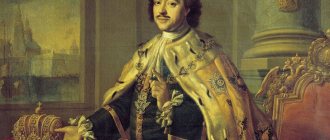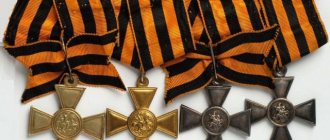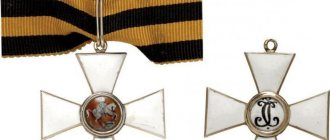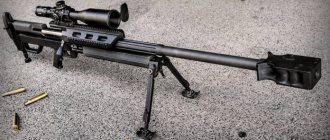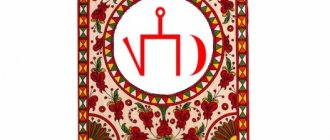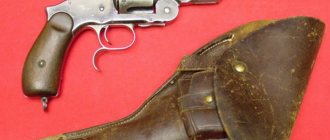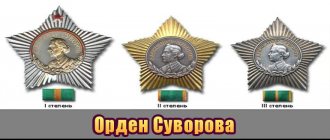The iconic award of the Russian Empire - the St. George Cross can be called the Order of Soldier's Glory. It was worn with pride, as a symbol of the highest valor. Among the cavaliers of “Egory,” as the cross was lovingly called by the people, there were outstanding Russian military leaders: Semyon Budyonny, Vasily Chapaev, Georgy Zhukov, Konstantin Rokossovsky, Rodion Malinovsky and Sidor Kovpak.
Historical reference
The Cross of St. George is often confused with the order of the same name, but we are talking about a separate insignia ranked among this highest military award. It was established specifically for the rank and file and non-commissioned officers of the Russian armed forces. The statute stated that the award was made “for excellent courage shown on the battlefield, in the defense of fortresses or in naval battles.” The holders of the insignia should not just participate in battles, but accomplish a feat, inspiring their comrades with their actions. For example, to be the first to enter an enemy fortress during an assault, to obtain valuable information about the enemy, or to save a higher rank in a difficult situation, with a threat to one’s own life.
"Soldier Egory"
In 1769, Catherine II founded the Imperial Military Order of the Holy Great Martyr and Victorious George to reward the officer class for courage in battle and long service. Thus, the Russian ruler, who came to power through a coup and did not have formal rights to the throne, wanted to enlist support from the nobility.
The highest award, awarded exclusively for military exploits, was highly valued by representatives of the aristocracy, since there were no analogues to it in the history of the state. Meanwhile, the courage of Russian soldiers also required honors and encouragement from the crown. The first awards for lower military ranks were introduced by Paul I, but only under his son, Alexander I, did the most widespread and revered of them appear.
The insignia, which was to be considered as the Vth degree of the Military Order of St. George in addition to the four existing ones, was established by a special imperial decree in 1807. Alexander I, who had recently ascended the throne, was prompted to this decision by the escalating European conflict with Napoleon, as well as successful military campaigns in Iran (1804-1813) and Turkey (1806-1812). There is information that the emperor was presented with a note asking for the creation of a “soldier Yegoriy,” but its author remained unknown. In the statue of the award, a special clause stipulated that it be attached to a ribbon similar to the order.
They were the first
The first award of the order took place in 1807 near Friedland (today the city of Pravdinsk, Kaliningrad region), where the Russian army clashed with Napoleon's troops during the latter's attempt to capture Prussia. The list of gentlemen of the “soldier Yegor” was opened by non-commissioned officer Yegor Mitrokhin, an orderly of Adjutant General Fyodor Uvarov, one of the imperial favorites. Then three more of his comrades received awards.
The period of the Napoleonic wars was especially generous with order insignia. From 1807 to 1811 alone, 12,871 awards were made. Among the most unusual gentlemen:
- Ulan Nadezhda Durova, nicknamed the “cavalry maiden”. She carried out the wounded commander from the bullets in the battle near Gugstadt.
- A French soldier, whose name is unknown, during the exchange of awards during the Peace of Telsit.
- Pomeranian tradesman Matvey Gerasimov. Far from a military profession, a grocery merchant managed to show courage and ingenuity when his boat was captured by the British while transporting a load of flour. The Russian team of 9 people was able to not only neutralize the attackers, but also capture them and take them to the Norwegian port of Vardø. The courageous Pomor was awarded, but he never became a holder of the military regalia.
In January 1809, the badge of honor began to be numbered and personal lists of nominees were introduced. The charter of the “soldier Egory” allowed it to be presented an unlimited number of times. But the cross was issued only once, and in other cases the salary was increased by a third, up to a double increase in salary. And the most important point is that holders of the order were not subjected to corporal punishment, which was actively used in the Russian armed forces until 1904.
New in blogs
This cross is the most famous award. The badge, known in the military history of Russia as the “St. George Cross”, is the most legendary, revered and widespread award of the Russian Empire.
1. Institution.
The original name of the award was “Insignia of the Military Order of the Holy Great Martyr and Victorious George.” It was established by the Highest order of Emperor Alexander I of February 13 (23), 1807. The task is to encourage and celebrate the courage of lower ranks. The name of the first recipient is known - Yegor Ivanovich Mitrokhin, non-commissioned officer of the Cavalry Regiment - for the battle at Friedland, in Prussia on December 14, 1809, “for skillful and brave execution of orders.” Friedland is the current city of Pravdinsk. These are different awards, with different statuses. And they look different.
2. Award rules.
Unlike all other soldier’s medals, the cross was awarded exclusively for a specific feat, for “this insignia is acquired only on the battlefield, during the siege and defense of fortresses, and on the waters in naval battles.” The list was clearly and down to detail regulated by its Status. It is characteristic that not only a soldier could receive an award for the feat indicated there. The future Decembrists Muravyov-Apostol and Yakushkin, who fought at Borodino with the rank of ensign, which did not give the right to an officer's award, received St. George's Crosses No. 16697 and No. 16698. There is a known case of a general being awarded a soldier's award - Count Mikhail Miloradovich in a battle with the French in a soldier's ranks in the battle near Leipzig received the St. George Cross, 4th degree. The vicissitudes of fate - in 1825 he was shot dead on Senate Square by the Decembrist Kakhovsky.
3. Privileges.
The lower rank - holder of the St. George Cross in the army was spared from corporal punishment. The soldier or non-commissioned officer awarded it received a salary one third more than usual, for each new cross the salary was increased by another third until the salary doubled. The additional salary remained for life after retirement; widows could receive it within a year after the death of the gentleman. Award block from the time of the Crimean War: Insignia of the military order of the Holy Great Martyr and Victorious George, medals - “For the defense of Sevastopol” and “In memory of the Crimean War of 1853 - 1854 - 1855 - 1856.” The block was tied to the uniform with strings.
4. Degrees.
On March 19, 1856, four degrees of awards were introduced, and awards were made sequentially. The badges were worn on a ribbon on the chest and were made of gold (1st and 2nd) and silver (3rd and 4th). The numbering of characters was no longer general, but began anew for each degree. “Either his chest is covered in crosses, or his head is in the bushes” - that’s all about him.
5. Knight of St. George. Full Knight of St. George - all four degrees of the cross, 1st and 3rd degree - block with a bow. The two medals on the right are “For Bravery.”
The only one who received crosses 5 times was Semyon Mikhailovich Budyonny, and because of his love for fighting. He was deprived of his first award, the St. George Cross of the 4th degree, in court for assault on a senior in rank. I had to receive the award again, this time on the Turkish front, at the end of 1914. He received the St. George Cross, 3rd degree, in January 1916 for participating in the battles near Mendelij. In March 1916 - awarded the cross of the 2nd degree. In July 1916, Budyonny received the St. George Cross, 1st degree, for the fact that five of them brought 7 Turkish soldiers from a sortie.
6. Women.
There are several known cases of women being awarded the cross: this is the “cavalry maiden” Nadezhda Durova, who received the award in 1807; in the lists of cavaliers she is listed under the name of cornet Alexander Alexandrov. For the battle of Dennewitz in 1813, another woman received the St. George Cross - Sophia Dorothea Frederica Kruger, a non-commissioned officer from the Prussian Borstell brigade. Antonina Palshina, who fought in the First World War under the name Anton Palshin, had the St. George Cross of three degrees. Maria Bochkareva, the first female officer in the Russian army, commander of the “women’s battalion of death” had two Georges.
7. For foreigners. 8. For non-believers.
From the end of August 1844, a special cross was installed to reward military personnel of other religions; it differed from the usual one in that the coat of arms of Russia, a double-headed eagle, was depicted in the center of the medallion. The first full holder of the cross for non-believers was Labazan Ibrahim Khalil-ogly, a police cadet of the 2nd Dagestan Cavalry Irregular Regiment.
9. The feat of “Varyag”. Award block for the lower rank of the cruiser crew. On the right is a specially established medal “For the battle of the Varangian and the Korean on January 27, 1904 - Chemulpo” Gift address to the crew members from the Assembly of the Nobility of St. Petersburg.
10. St. George's Cross.
The award began to be officially called the St. George Cross in 1913, when the new statute of the “insignia of the Military Order” was approved, and the numbering of crosses began anew from that time. The new statute also introduced lifelong allowances: for the 4th degree - 36 rubles, for the 3rd degree - 60 rubles, for the 2nd degree - 96 rubles and for the 1st degree - 120 rubles per year, for gentlemen of several degrees an increase or the pension was paid only for the highest degree. A pension of 120 rubles in those days was quite a decent amount; the salary of a skilled worker in 1913 was about 200 rubles a year.
11. About numbering.
The first crosses of 1807 were not numbered. This was corrected in 1809, when it was ordered to compile precise lists of gentlemen, and the crosses were temporarily removed and numbered. Their exact number is known - 9,937. Numbering allows us to determine who owned the award. This cross of the 4th degree - junior non-commissioned officer of the Grenadier Corps of the engineer battalion Mikhail Bubnov, order dated July 17, 1915 No. 180, distributed by Grand Duke Georgy Mikhailovich on August 27 of the same year (RGVIA archive, fund 2179, inventory 1, file 517 ).
The numbering of the crosses was renewed several times - by the different design of the numbering font, you can determine which period the award belongs to. When during the First World War the number of awards exceeded a million, the designation 1/M appeared on the reverse, on the upper ray of the cross.
12. St. George's ribbon. It is traditionally believed that the colors of the ribbon - black and yellow - mean “smoke and flame” and are a sign of a soldier’s personal valor on the battlefield. Another version is that these colors are based on the life of St. George the Victorious and symbolize his death and resurrection: St. George went through death three times and was resurrected twice. There is a simpler version. The colors of the ribbon when establishing the Order of the Holy Great Martyr and Victorious George in 1769 were established by Catherine II and for the color of the ribbon she took the colors of the imperial standard: black and yellow-gold, excluding white.
13. After February 17th. Left: St. George's Cross with a laurel branch. This was awarded to officers who distinguished themselves in battle after February 1917. To receive an award, a decision of a meeting of lower ranks was required. Right: Posters 1914 - 17
14. Against the Bolsheviks.
During the Civil War in the White Army, awarding military awards was rare, especially in the initial period - the White Guard considered it immoral to award military awards to Russians for their exploits in the war against the Russians. General Wrangel, in order not to award the Cross of St. George, established a special order of St. Nicholas the Wonderworker, which was equivalent to the St. George's.
15. Cross in the Great Patriotic War.
Legend claims that during the Great Patriotic War the possibility of restoring the award and resuming the award of the St. George Cross was considered, but was rejected due to its religious background. The Order of Glory, a soldier's award - a star on the block of the St. George Ribbon, has a very similar award status with the St. George Cross. 1945. Demobilized soldiers who arrived in Leningrad. On the right is a participant in three guard wars, Private F. G. Vadyukhin. A famous photograph testifying to an unusual rule for the Red Army that appeared during the war - holders of the Cross of St. George were unofficially allowed to wear these awards.
Photo link: https://waralbum.ru/38820/
Philip Grigorievich Vadyukhin was born in 1897 in the village of Perkino, Spassky district, Ryazan province. Drafted into the Red Army on October 16, 1941 by the Vyborg RVK of the city of Leningrad. He was a rifleman, then a medical instructor in the 65th Guards Rifle Regiment of the 22nd Guards Rifle Division of Riga. In addition to the St. George Cross and the Guards Badge, the photo shows four stripes for wounds, the Order of the Red Star, the Order of Glory of the third degree (he was awarded for providing assistance to 40 wounded and evacuating 25 wounded under enemy fire on December 26-31, 1944 in the area of the village of Muzikas in Latvia ) and two medals “For Courage”.
16. Archive. Data on the recipients is currently stored in the Russian State Military Historical Archive (RGVIA) in Moscow. The data is incomplete - some of the documents from military units did not have time to get into the archive due to the events of the 17th. After the First World War, it was planned to build a temple and memorial dedicated to all the Knights of St. George, but for known reasons the good initiative was never realized.
17. Nowadays.
The Russian military Order of St. George and the sign "St. George's Cross" were restored in the Russian Federation in 1992 by Decree of the Presidium of the Supreme Council of the Russian Federation dated March 2, 1992 No. 2424-I "On state awards of the Russian Federation." 11 people were awarded. No comments.
18.P. _ _ S. _ — private opinion about the St. George’s Ribbon.
I don’t wear the St. George’s ribbon on Victory Day. I don’t even attach it to the car. The ribbon is always the badge of the recipient of the award. I did not “take away the enemy’s banner or standard,” or even “take away our banner or standard, captured by the enemy.” And if you don’t deserve it, then you’re not worthy to wear it.
Application (for amateurs). Continued at the link: https://hanzzz-muller.livejournal.com/
19. Manufacturing technology. "GEORGE'S CROSS" - AT THE MINT.
Magazine "Ogonyok" No. 5 dated February 1 (14), 1915, pp. 5-6
20. Authenticity check.
Description of the insignia of the Military Order of St. George
In the early version, the Teutonic cross was made of 990 (old 95) standard silver. In the center on the obverse there was a medallion with the image of St. George the Victorious. On the reverse, in the same place, there was a monogram of the letters “C” and “G”. The number of the sign was indicated on the lower ray on the back. Since 1833, for persons who have been awarded multiple awards, a bow from the St. George Ribbon began to be attached to the award. In 1839, a commemorative version was minted with the personal monogram of the reigning emperor on the upper ray.
Muslim "bird"
In 1844, Alexander I introduced a special design of the honorary badge “Egoria” for Muslims. Thanks to the loyal policy of the sovereign, many peoples professing Islam fought on the side of the Russian army: Tatars, Bashkirs, Kalmyks, Chechens. To avoid discrimination, the decorations issued to Muslim soldiers did not depict a Christian saint, but a “neutral” imperial eagle.
However, not all heroes appreciated such scrupulousness. Muslim soldiers wanted to see a “real horseman”, just like themselves, on their awards, and not an obscure “bird.”
Introduction of degrees
In 1856, the reformer Tsar Alexander II established 4 degrees of honorary badge. Getting the eldest of them bypassing the younger ones was impossible. A strict selection of candidates was carried out, and therefore, over the half-century of the existence of the “soldier Egory”, only 2,000 people became its full cavaliers.
The design as a whole has been preserved, some changes affected only the reverse. The degree began to be indicated on the lower beam, and the number of the sign was located on the crossbar on both sides of the medallion with a monogram. Both relief and counter-relief carvings were used for decoration.
After the reform of 1956, numbering was carried out from scratch, separately for each degree. In addition to silver, gold began to be used for coinage. It was intended for “Egories” of the 1st and 2nd degrees, and silver was left for the 3rd and 4th. The weight of the gold award was 12.5 g, the silver award was 10.5 g.
St. George's Cross
This is exactly how the former “Egory” began to be called in 1913, which led to changes in the statute - specific amounts of bonuses for awards and the rules for their payment were established, as well as the procedure for increasing ranks for gentlemen. The award was allowed to be made posthumously. The update also affected the design of the St. George Cross - a ribbon with a bow was now provided for the 1st and 3rd degrees. In connection with the adjustment of the statute and name, the previous numbering was “reset to zero”.
With the outbreak of the First World War, awards became widespread again. The IV degree badge has been awarded to more than 1 million people and at least 30,000 have received the highest distinction. Women often became knights, primarily sisters of mercy, who showed incredible courage when rescuing the wounded in the field. One of them, Rimma Ivanova, was awarded not only the Egoria Cross, but also the Order. Such an honor has never been given to any other woman in Russia, except for the founder of the award, Catherine II. The number of foreign nominees who fought on the side of the Russian army also increased.
Troubled times
In 1915, many gold and silver awards began to be made from cheaper alloys. The innovation also affected the St. George Cross; the gold content in it was reduced to 60%. Rare copies of that time can be identified by a stamp with a profile image near the letter “C” in the word “STEP”. Silver samples have not changed.
In 1916, due to the difficult economic situation, the use of precious metals had to be completely abandoned. Gold was replaced with tombak (an alloy of copper and zinc), and silver with cupronickel (copper with nickel). This was indicated by the designations on the transverse cross bar: “ZhM” and “BM”, respectively.
The revolutionary year of 1917 brought another important change - the Provisional Government allowed the “soldier's Yegor” to be awarded to officers who showed “unparalleled courage in a combat situation.” In this case, the St. George ribbon was decorated with a gold or silver laurel branch, depending on the degree being awarded.
During the February Revolution, the people's insignia was actively used for political purposes. Thus, “Yegory” II and IV degrees were awarded to Prime Minister Alexander Kerensky with the wording: “To the undaunted hero who tore down the banner of tsarism.” With the coming to power of the Bolshevik regime, the most democratic of all imperial awards was abolished along with the rest.
Soviet era
In 1918-1922, the presentation of the St. George Cross continued in the White Guard troops, which did not have their own award system. The copies used were minted back in tsarist times by the St. Petersburg Mint. The exception was the awards intended for the villagers of the Don Army. On them, taking into account the specifics of the nominees, the popular snake-wrestler saint was depicted with a lush forelock and beard, dressed in full Cossack uniform.
It was the Don Cossack, 18-year-old Pavel Zhadan, who in 1920 became the last gentleman of the “soldier Yegor” during the Civil War for the successful operation to defeat the red cavalry near Melitopol. At its end, the leaders of the White Guard movement who emigrated to Europe, in particular, the Commander-in-Chief of the Russian Army Pyotr Wrangel and the head of the Northern Front Evgeniy Miller, maintained the tradition of awarding until 1930.
Dark page
The Cross of St. George, a symbol of the heroic spirit of the nation, was awarded to representatives of the so-called Russian Security Corps during the Second World War. This Nazi formation consisted of emigrants and Soviet citizens who defected to the German side. The corps took part in operations against Yugoslav partisans, and since 1944 directly fought with Red Army units on the border with Serbia.
Awards to collaborators were spontaneous and were not confirmed by official documents. The names of two servicemen of the corps who received the St. George Cross, IV degree in 1941 are known:
- doctor Nikolai Golubev;
- Junker Sergei Shaub.
There is no other information about the awarding of “Yegory” during the Soviet period. Attempts were made to equate the Knights of St. George with the holders of the Order of Glory with the same benefits and insignia. But the project did not progress further.
Russian Federation Award
In 1992, the St. George Cross was restored and officially included in the state award system. Its design was completely preserved, but instead of gold, gilded silver was used. Until 2010, not only ordinary soldiers of the Armed Forces, but also junior officers were awarded, but this item was abolished, again making “Yegory” an exclusively soldier’s privilege.
For fastening, a pentagonal block is used, covered with moire tape with easily recognizable orange and black stripes. The bow is still provided only for degrees I and III. In addition to the state award, there are several other options for public awards that are similar to the St. George Cross.
The most famous Knights of St. George
Over the entire existence of this award, about 3.5 million St. George Crosses of various degrees have been issued. Among the holders of this insignia are many famous personalities who can safely be called historical.
Soon after the award appeared, the famous “cavalry maiden” Durova received it; the cross was awarded to her for saving the life of an officer.
The former Decembrists Muravyov-Apostol and Yakushkin were awarded the Crosses of St. George - they fought at Borodino with the rank of ensigns.
General Miloradovich also received this soldier's award for his personal participation in the Battle of Leipzig. The cross was presented to him personally by Emperor Alexander, who witnessed this episode.
A very famous character for his era was Kozma Kryuchkov, the first cavalier of the “George” of the First World War.
The famous division commander of the Civil War, Vasily Chapaev, was awarded three crosses and the St. George medal.
The holder of the St. George Cross was Maria Bochkareva, the commander of the women’s “death battalion” created in 1917.
Despite the huge number of crosses issued over the entire period of existence of this award, today this insignia is a rarity. It is especially difficult to buy the St. George Cross of the first and second degrees. Where did they go?
After the February Revolution, the Provisional Government issued a call to donate its awards to the “needs of the revolution.” This is how Georgy Zhukov lost his crosses. Many awards were sold or melted down during periods of famine (there were several during the Soviet period). Then a cross made of silver or gold could be exchanged for several kilograms of flour or even a couple of loaves of bread.
St. George medal
The medal, established in 1913 and also assigned to the Order of St. George, was awarded not only to lower military ranks, but also to civilians who showed special courage in combat conditions. First of all, we were talking about medical personnel - paramedics and orderlies, whose hard work on the front line was in no way inferior to that of a soldier.
The design of the medal was laconic. The obverse depicted a relief profile of Nicholas II, indicating his official title along the edge. On the reverse there is the inscription: “FOR BRAVERY”, serial number and degree of regalia.
Description of degrees
| Degree/Characteristic | I | II | III | IV |
| Metal | gold | gold | silver | silver |
| Ribbon | with bow | standard St. George | with bow | standard St. George |
| Annual payments to recipients (rubles of Tsarist Russia) | 36 | 24 | 18 | 12 |
In 1916, gold and silver were replaced by alloys. There is a mark about this on the obverse of the medal before the inscription: “NICHOLAS II...”.
